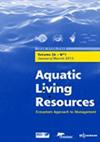墨西哥东南部特有蜗牛Pomacea patula catemacensis (Baker 1922)小规模养殖的经济可行性分析
IF 1.5
4区 农林科学
Q3 FISHERIES
引用次数: 0
摘要
蜗牛Pomacea patula catemacensis是墨西哥湾东南部的一种特有软体动物,自2010年以来,这种软体动物被商业开发,数量正在减少。这种下降与市场需求的增加和非法捕捞有关。我们设计了一个小规模生产系统,并确定了其基本方案的财务可行性。我们利用从利益相关者那里收集的信息和随机模型来预测不确定变量对经济指标的影响,以评估不同条件下的财务可行性。小型集约化生产系统的设计产量为3.9吨/年的无壳产品,需要投资约6.5万美元。考虑到14%的贴现率和7%的再投资率,使用修正内部收益率和现金流净现值对生产单位进行了财务评估。我们获得的净现值为67,000美元,基本方案的修正内部回报率为20%,这表明项目的可行性。通过蒙特卡罗模拟来评估项目对三个参数(劳动力成本、能源成本和市场价格)变化的鲁棒性;随机和同步变化,导致95%的概率获得修正内部收益率大于当前利率(8%),并且在财务上不可行的概率很低(2.8%)。这种生产系统值得考虑,作为一种选择,可以减少对Catemaco湖tegogolo自然种群的捕捞压力,同时满足市场需求。本文章由计算机程序翻译,如有差异,请以英文原文为准。
Economic feasibility analysis of small-scale aquaculture of the endemic snail Pomacea patula catemacensis (Baker 1922) from southeast Mexico
The snail Pomacea patula catemacensis is an endemic mollusk from the southeast Gulf of Mexico, which is commercially exploited and in decline since 2010. This decline is associated with an increasing market demand and illegal capture. We designed a small-scale production system for P. p. catemacensis and determined its financial feasibility for a base scenario. We used information gathered from stakeholders and stochastic modeling to predict the impact of uncertain variables on the economic indicators to assess the financial viability under varying conditions. The small-scale intensive production system, designed to yield 3.9 tons/year of unshelled product, requires an investment of about US $65,000. The production unit was financially assessed using the Modified Internal Return Rate and The Net Present Value of cash flow, considering a 14% discount rate and a 7% reinvestment rate. We obtained a Net Present Value of $67,000 and a Modified Internal Return Rate of 20% for the base scenario, which indicates the viability of the project. A Monte Carlo simulation was run to assess the robustness of the project to variability of three parameters: labor cost, energy cost, and market price; with random and simultaneous variation, resulting in 95% probability of getting a Modified Internal Return Rate larger than the current interest rate (8%) and a low probability (2.8%) to be financially unviable. This production system is worthy of consideration as an option to reduce the fishing pressure on the tegogolo natural populations of the Catemaco Lake while satisfying the market demand.
求助全文
通过发布文献求助,成功后即可免费获取论文全文。
去求助
来源期刊

Aquatic Living Resources
农林科学-海洋与淡水生物学
CiteScore
2.30
自引率
0.00%
发文量
10
审稿时长
>24 weeks
期刊介绍:
Aquatic Living Resources publishes original research papers, review articles and propective notes dealing with all exploited (i.e. fished or farmed) living resources in marine, brackish and freshwater environments.
Priority is given to ecosystem-based approaches to the study of fishery and aquaculture social-ecological systems, including biological, ecological, economic and social dimensions.
Research on the development of interdisciplinary methods and tools which can usefully support the design, implementation and evaluation of alternative management strategies for fisheries and/or aquaculture systems at different scales is particularly welcome by the journal. This includes the exploration of scenarios and strategies for the conservation of aquatic biodiversity and research relating to the development of integrated assessment approaches aimed at ensuring sustainable and high quality uses of aquatic living resources.
 求助内容:
求助内容: 应助结果提醒方式:
应助结果提醒方式:


